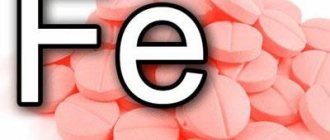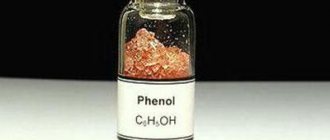Views: 10038
Absolutely all varieties of phenol are considered poisonous and also a very dangerous substance for human health and life. However, despite this, it is produced annually all over the world in huge quantities. Once in the human body, phenol can provoke the development of dangerous and very severe poisoning.
When phenol enters the human body, it can cause poisoning, accompanied by unpleasant and painful symptoms that have a negative impact on life and health. Phenol poisoning is a very dangerous disease, as it is considered one of the most powerful toxic substances.
Formaldehyde
gaseous substance with a pungent odor. In industry, an aqueous solution of formaldehyde is usually used - formalin (stabilized with methanol) or methanediol (without methanol).
FK plywood can be recognized by the light adhesive layers of urea-formaldehyde resin. This resin contains formaldehyde, but does not contain phenol.
Formalin can cause denaturation of proteins, due to which it is used as an antiseptic in medicine (of course, in a very weak solution), as well as in the creation of anatomical preparations.
In industry, formaldehyde is used very widely - primarily for the production of synthetic resins (phenol-formaldehyde, urea-formaldehyde, melamine-formaldehyde). In addition, it is used in very small quantities in the production of cosmetics and some pharmaceuticals.
Formaldehyde itself is a fairly strong poison. It irritates the mucous membranes and has a destructive effect on the respiratory tract. When formaldehyde enters the bloodstream (through the respiratory system or as a product of methanol oxidation), it seriously affects the nervous and reproductive systems, as well as the eyes.
According to IARC Monographs on the Evaluation of Carcinogenic Risks to Humans
"(
WHO, International Agency for Research on Cancer
), pure phenol in the form of liquid and vapor or contained in other products (cosmetic peels, alflutop) can affect the eyes, skin, respiratory tract and nervous system of humans. Repeated or prolonged skin contact with phenol causes dermatitis, up to second and third degree burns. Inhalation of phenol vapor leads to pulmonary edema. The substance may have adverse effects on the central nervous system and heart, leading to arrhythmias, seizures and ultimately coma. Long-term or repeated exposure to the substance, as in the case of aflutop, may have adverse effects on the liver and kidneys. The toxicity of phenol is determined by hydrophobic effects and the formation of phenoxyl radicals. It is especially dangerous when phenol is mixed with chloroform (this mixture is usually used in molecular biology to purify DNA and RNA).
Phenol poisoning occurs during its production and use, as with the use of phenolic resins in the wood industry. It is also found in automobile exhaust and tobacco smoke.
- Oncogenicity in humans:
A study of Finnish carpenters found a high risk of lung cancer in people exposed to phenol, although the risk was greater in short-term workers. This finding was not replicated in three other studies that tested the association of phenol with lung cancer, although two of them had very low statistical power. However, all subsequent studies either showed an association of phenol with cancer of various sites, or reported an increased risk of cancer, but only of certain sites.
- Oncogenicity in animals
:
Phenol was tested for carcinogenicity by oral administration in rats and mice. An increased incidence of leukemia was observed in male rats at low concentrations, but not in rats at high dosages or in female mice and rats. Phenol promoted tumorigenesis in mouse skin in a two-step protocol.
Phenol is well absorbed from the gastrointestinal tract and through the skin of animals and humans. It is metabolized primarily by conjugation (sulfation and glucuronidation) or, to a lesser extent, by oxidation, forming quinone-like reactive intermediates that are able to covalently bind to proteins and are detoxified by conjugation to glutathione. Topically applied phenol causes skin irritation, and systemic toxicity in the form of liver and kidney damage can occur after topical and oral dosing.
Following in vivo administration, phenol causes nuclear breakdown in mice and chromosomal aberrations in rats. It also induces oxidative DNA damage in mice, and binds covalently to DNA in rats. In cultured mammalian cells, phenol causes mutations, sister chromatid exchange, and the formation of micronuclei. It binds to intracellular protein (but not DNA) and inhibits intercellular communication.
Formaldehyde
and its aqueous solution,
formaldehyde,
is a known carcinogen (i.e., a substance that causes cancer). Used in agriculture as a germicide, fungicide and insecticide. Penetrating into the digestive tract it causes symptoms of severe poisoning - severe abdominal pain, vomiting with blood, protein in the blood and urine, kidney damage, resulting in cessation of urine output, acidosis, coma and death. https://www.rifinfo.ru/news/7371
So a city resident living in an apartment filled with phenols from furniture and paints, breathing phenols, drinking phenols, consuming medicines with phenols “for joints”, doing Mantoux tests, can hardly be healthy and can hardly have healthy children, if at all to have children.
Phenol has two other names: carbolic acid and hydroxybenzone. Answering the question of what phenol is, it should be noted that it is an element of organic origin that belongs to the class of hydrocarbons. Outwardly, it resembles small needle-shaped crystals of a transparent whitish hue. The smell of phenol is similar to the smell of gouache paints. In air, interacting with oxygen, it changes color to light pink.
Basic properties
The substance has moderate solubility in water (when heated to 700 degrees - in any proportion), and good in oils, alcohol-containing liquids, acetone and alkalis. When interacting with water vapor, it becomes volatile.
Sources of poisoning
The wide range of applications leads to the likelihood of a high frequency of cases of intoxication.
More than 40% of the substance is used in the chemical industry for the production of other organic compounds, in particular resins.
Scope of application
The properties of a substance are used in the following areas:
- chemical industry: in the production of synthetic fibers, various solutions with cleaning and disinfecting properties, dyes;
- oil refining sector: for selective purification of various oils;
- agricultural industry: for disinfection of livestock, treatment of plants against diseases and protection against weeds;
- woodworking sphere: as an additive to glue and wood;
- food industry: to ensure the preservative abilities of smoke smoke;
- cosmetology area: for peeling;
- pharmaceuticals: as a preservative in solutions for vaccines, in the manufacture of medicines;
- medical field: a solution of phenol in water, as an antiseptic, a remedy for the treatment of fungal diseases of the skin, genital warts, inflammation of the ear, as a disinfectant solution for caring for the sick, for linen, and for cleaning premises.
Degree of toxicity
Phenol is very toxic and sometimes causes irreparable harm to overall health.
It is classified as hazard class II. The degree of exposure of phenol to the human body is quite high.
The substance enters the body in several ways, in particular through the respiratory organs and the surface of the skin, as well as the mucous membrane. And it is eliminated by the kidneys and, by inhaling vapors, through the lungs.
Pharmacodynamics
In addition to being antiseptic, it has a bactericidal effect on vegetative forms of bacteria and fungi. The weak effect of phenol on spores is due to its insufficient solubility in water.
Has disinfecting abilities.
It binds with the proteins of the infected cell, causing destruction of their native structure and the colloidal property of the cell. In addition, the substance dissolves in the membrane lipids of the infected cell, increasing its permeability and affecting the oxidative-regenerating internal processes.
In a liquid of 1.25% concentration, most of the microbes die after 5-10 minutes at room temperature.
The bactericidal effect is enhanced at higher temperatures, in acidic conditions.
Pharmacokinetics
The drug is easily absorbed through the surface of the skin, as well as mucous membranes, and is perfectly adsorbed by food products. Very toxic if absorbed systemically.
About 20% of the dose taken is subject to oxidation. The end products of metabolism are phenyl glucuronide and phenyl sulfate. The oxidation products are catechols and quinols, mainly conjugated. Metabolic products are eliminated by the kidneys, and quinones give the urine a dark brown or greenish tint.
Only a small amount of the substance is eliminated as a “free” element. Considering the fact that free phenol is concentrated in the bloodstream, toxicity is directly related to this.
Characteristics of the substance
Everyone knows that phenol has a harmful effect on the human body and its health, so you need to be extremely careful and follow safety precautions. As for phenol, these are peculiar crystals that have no color, and are also capable of instantly oxidizing in the air and turning pink. It has a rather sharp and very specific smell, and has some similarities with gouache.
It dissolves well in water, acetone, oil, alkalis, and alcohol. Temperature plays an important role, which should not exceed seven hundred degrees Celsius. It is quite easily and quickly adsorbed by food products.
Phenols include:
- creosote;
- butylphenol;
- hydroquinone;
- chlorophenol;
- Lysol and others.
Phenol is crystals
Phenols are compounds consisting of one or more atoms. Most phenols, consisting of one atom, are colorless crystals. They have a specific smell, but are difficult to dissolve in water. But they dissolve well in special solvents and melt at low temperatures.
If phenols are stored in the open air for a long time, they oxidize and acquire a darker color than the original one. For example, carbolic acid, one of them, turns pink when in contact with air as oxidation occurs.
Despite their toxic properties, these substances have a number of beneficial properties. For example, they kill harmful microbes and bacteria and have an antiseptic effect.
Some phenols:
- phloroglucinol;
- anthranol;
- Lysol;
- naphthol;
- butylphenol;
- resorcinol;
- pyrogallol;
- ethylphenol
These are some examples of what the names of phenols look like. If the names say little, then the opposite is the case with areas of application, by which one can judge the usefulness of phenols.
Possibility of intoxication
Toys that do not comply with GOST standards can lead to poisoning
The causes of phenol poisoning are non-compliance with instructions and safety rules when working with the substance, violation of the dosage regimen during treatment, violation of regulations for the storage of phenol-containing drugs, the use of plastic toys by children that do not comply with GOST indicators, etc.
The likelihood and danger of poisoning for a child is that the substance smells like gouache, which provokes a situation of accidental ingestion by children.
People working in industries where phenol is used are at primary risk because of the increased risk of inhaling vapors.
Acceptable average daily norms
Once it reaches the surface of the skin, even if there are no damaged areas, it is quickly absorbed. Within minutes, the toxic effect on the brain appears.
The lethal norm for a healthy adult when administered orally is considered to be within the range of 1-10 g, and for therapy in children - 0.03-0.5 g.
A poisonous effect on almost all cells is possible due to structural changes in protein molecules, accompanied by a violation of their properties and the loss of cellular proteins in the form of sediment. This is fraught with the development of tissue necrosis.
The maximum permissible dose in the air is 0.01 mg/m3, remaining in it for an hour.
The average daily dose in the air is 0.003 mg/m3.
Symptoms
The harm of phenol exposure to humans is obvious. Noting why the drug is dangerous, we should mention its ability to penetrate the blood-brain barrier and spread through the bloodstream to all tissues and cells of the body.
Symptoms characterizing phenol poisoning are as follows:
- Initially, the victim experiences slight excitement, which quickly passes and is replaced by irritation. Later, a state of apathy, indifference and depression develops.
- Loss of strength and weakness are growing dynamically. Tactility decreases, while the reaction to changes in illumination intensifies. The poisoned person experiences a feeling of nausea, dizziness, and severe headaches. Convulsions and loss of consciousness are possible.
- The skin turns pale and becomes cold to the touch. Sometimes there is cyanosis of the skin.
- When inhaling fumes, shortness of breath develops and breathing becomes rapid. Constant sneezing is caused by irritation of the nasal mucosa. As the degree of toxemia increases, spastic phenomena in the larynx and a dry cough occur.
In cases of severe toxemia, spasms of the trachea and bronchi are possible, which can lead to suffocation and death.
Causes of poisoning
Phenol poisoning can occur for the following reasons:
- dosage violation
violation of safety regulations while working with them;
- accidental ingestion of a toxic substance;
- suicide attempt;
- violation of dosages and rules of use of medicines;
- violation of the rules for storing medicines, disinfectants and household chemicals in places accessible to children;
- children's use of toys made of plastic that do not comply with GOST (in recent years, children have been poisoned when playing with dolls, even expensive ones made in China and Thailand).
Relief measures
Due to the risk of developing spastic contractions of the bronchi and other negative phenomena, calling a team of professionals is justified in any case of phenol poisoning. Before her arrival, primary care should be started immediately.
Pre-medical actions
If signs of poisoning by a substance are observed, it is urgently necessary to interrupt the victim’s contact with poisons. To do this, he is taken outside and freed from restrictive clothing. If the substance gets on the skin, wash it thoroughly with water.
In case of contact with skin, rinse with water.
If phenol poisoning occurs orally, treatment does not begin with medication. First you should rinse your mouth for 10-15 minutes.
If phenolic liquid penetrates into the stomach, sorbent preparations can be taken.
Gastric lavage procedure is not allowed. This is due to the risk of increasing the degree of burn, and will increase the location and extent of damage to the mucous membrane.
In a hospital setting
Further actions will be carried out by medical professionals. Where does treatment begin? The victim will be given an antidote. The drug calcium gluconate serves as an antidote.
To remove phenol from the body and prevent further harmful effects, the clinic uses the following basic procedures:
Calcium gluconate
- hemosorption is the process of circulating blood in a specialized apparatus;
- detoxification - the introduction of solutions that reduce the concentration of a toxic component in the bloodstream and promote its natural elimination through the kidneys;
- hemodialysis is the process of blood passing through a machine, through special membrane-like formations that trap toxins.
Additional treatment depends on which symptoms persist. They consist of procedures to restore the structure of the skin, the activity of the central nervous system and cardiovascular system, etc.
Formed on the basis of benzene. Under normal conditions, they are solid toxic substances with a specific aroma. In modern industry, these chemical compounds play an important role. In terms of volume of use, phenol and its derivatives are among the twenty most popular chemical compounds in the world. They are widely used in the chemical and light industries, pharmaceuticals and energy. Therefore, the production of phenol on an industrial scale is one of the main tasks of the chemical industry.
Consequences and complications
Phenol poisoning causes significant harm to the body. Severe forms of poisoning create the preconditions for the development of serious complications.
Potential effects of phenol poisoning:
- Violation of the erythrocyte blood formula with the development of systemic cardiovascular failure;
- Formation of generalized bronchopulmonary pathologies;
- Development of powerful allergic reactions, including autoimmune diseases;
- Kidney and liver failure, up to the stage of decompensation;
- Problems of the genitourinary area;
- Irreversible damage to the central nervous system with the development of persistent neurological and mental problems;
- Necrosis of external and internal tissues of the body;
- Fatal outcome with dosages of a toxic compound exceeding 10 grams one-time or due to long-term (more than 1 day) failure to provide qualified medical care for severe degrees of toxic damage;
- Other pathologies, syndromes, diseases, usually of the secondary spectrum, formed as a result of severe intoxication of the body.
Phenol designations
The original name of phenol is carbolic acid. Later, this compound was given the name “phenol”. The formula of this substance is shown in the figure:
The phenol atoms are numbered from the carbon atom that is connected to the OH hydroxo group. The sequence continues in such an order that the other substituted atoms receive the lowest numbers. Phenol derivatives exist in the form of three elements, the characteristics of which are explained by the differences in their structural isomers. Various ortho-, meta-, para-cresols are only a modification of the basic structure of the compound of the benzene ring and hydroxyl group, the basic combination of which is phenol. The formula of this substance in chemical notation looks like C 6 H 5 OH.
special instructions
Phenol has the ability to be adsorbed by food products.
The product should not be used on large areas of skin.
Before using the substance to disinfect household items, they must be mechanically cleaned, since the product is absorbed by organic compounds. After treatment, things can retain a specific odor for a long time.
The chemical compound cannot be used to treat premises for storing and preparing food products. It does not affect the color or structure of the fabric. Damages varnished surfaces.
Chemical properties
The unique properties of phenol are explained by its internal structure. In the molecule of this chemical substance, the p-orbital of oxygen forms a single p-system with the benzene ring. This tight interaction increases the electron density of the aromatic ring and decreases this indicator for the oxygen atom. In this case, the polarity of the bonds of the hydroxo group increases significantly, and the hydrogen included in its composition is easily replaced by any alkali metal. This is how various phenolates are formed. These compounds do not decompose with water like alcoholates, but their solutions are very similar to salts of strong bases and weak acids, so they have a fairly pronounced alkaline reaction. Phenolates react with various acids; as a result of the reaction, phenols are reduced. The chemical properties of this compound allow it to react with acids, forming esters. For example, the reaction of phenol and acetic acid leads to the formation of phenyl ester (phenyacetate).
The nitration reaction is widely known, in which, under the influence of 20% nitric acid, phenol forms a mixture of para- and orthonitrophenols. When phenol is treated with concentrated nitric acid, it produces 2,4,6-trinitrophenol, which is sometimes called picric acid.
Properties, receiving
The use of various halogens makes it possible to obtain phenolates, from which benzene is formed upon further processing. For example, heating sodium hydroxide and chlorobenzene produces sodium phenolate, which, when exposed to acid, breaks down into salt, water and phenol. The formula for such a reaction is given here:
C 6 H 5 -CI + 2NaOH -> C 6 H 5 -ONa + NaCl + H 2 O
Aromatic sulfonic acids are also a source for the production of benzene. The chemical reaction is carried out by simultaneous melting of alkali and sulfonic acid. As can be seen from the reaction, phenoxides are formed first. When treated with strong acids, they are reduced to polyhydric phenols.
Reviews
Phenol is a good antiseptic that is suitable both for the treatment of instruments and premises, and for the treatment of inflammatory ENT diseases. If you follow the doctor's recommendations and instructions for use, the necessary safety measures when working with such substances, the product is well tolerated and does not cause negative effects on the body. Reviews about the use of Phenol preparations are usually positive. Particularly good reviews for the treatment of throat diseases.
Phenol in industry
In theory, the simplest and most promising way to obtain phenol looks like this: with the help of a catalyst, benzene is oxidized with oxygen. But until now, a catalyst for this reaction has not been selected. Therefore, other methods are currently used in industry.
A continuous industrial method for producing phenol consists of the interaction of chlorobenzene and a 7% sodium hydroxide solution. The resulting mixture is passed through a one and a half kilometer system of pipes heated to a temperature of 300 C. Under the influence of temperature and maintained high pressure, the starting substances react, resulting in 2,4-dinitrophenol and other products.
Not long ago, an industrial method for producing phenol-containing substances using the cumene method was developed. This process consists of two stages. First, isopropylbenzene (cumene) is obtained from benzene. To do this, benzene is alkalated with propylene. The reaction looks like this:
After this, cumene is oxidized with oxygen. The output of the second reaction is phenol and another important product, acetone.
Phenol can be produced on an industrial scale from toluene. To do this, toluene is oxidized on oxygen contained in the air. The reaction occurs in the presence of a catalyst.
Indications for use
Application of Phenol:
- for disinfection of instruments and linen and disinsection;
- as a preservative in some medications. products, vaccines, suppositories and serums;
- for superficial pyoderma
,
folliculitis
,
phlyctene
,
ostiofolliculitis
,
sycosis
, streptococcal
impetigo
; - for the treatment of inflammatory diseases of the middle ear, oral cavity and pharynx, periodontitis
, genital
warts
.
Examples of phenols
The closest homologues of phenols are called cresols.
There are three types of cresols. Meta-cresol under normal conditions is a liquid, para-cresol and ortho-cresol are solids. All cresols are poorly soluble in water, and their chemical properties are almost similar to phenol. In their natural form, cresols are found in coal tar; in industry they are used in the production of dyes and some types of plastics.
Examples of diatomic phenols include para-, ortho-, and meta-hydrobenzenes. All of them are solids, easily soluble in water.
The only representative of trihydric phenol is pyrogallol (1,2,3-trihydroxybenzene). Its formula is presented below.
Pyrogallol is a fairly strong reducing agent. It oxidizes easily, so it is used to produce oxygen-free gases. This substance is well known to photographers; it is used as a developer.
Phenols -
organic substances whose molecules contain a phenyl radical linked to one or more hydroxo groups.
Just like alcohols, phenols are classified
according to their atomicity, i.e. by the number of hydroxyl groups.
Monohydric phenols
contain one hydroxyl group in the molecule:
Polyhydric phenols
contain more than one hydroxyl group in molecules:
There are also polyhydric phenols containing three or more hydroxyl groups in the benzene ring.
Let's take a closer look at the structure and properties of the simplest representative of this class - phenol C 6 H 5 OH. The name of this substance formed the basis for the name of the entire cass - phenols.
Prevention
To prevent phenol poisoning, it is important to adhere to safety precautions. Industrial premises must be provided with supply and exhaust ventilation; smoking, eating and drinking water are prohibited in them. Work with phenol should only be carried out using personal protective equipment (respirators, rubber shoes and gloves, rubberized clothing).
When using products that contain phenol at home, you must be careful. You need to work with doors and windows open to ensure natural ventilation of the room. Protect the skin with long sleeves and gloves. Phenol should be stored in a locked cabinet, with the name, method of use, and expiration date indicated on the label.
Chemical properties of phenol
In most reactions, phenols are more active at the O–H bond, since this bond is more polar due to the shift of electron density from the oxygen atom towards the benzene ring (participation of the lone electron pair of the oxygen atom in the p-conjugation system). The acidity of phenols is much higher than that of alcohols. For phenols, reactions of C-O bond cleavage are not typical, since the oxygen atom is firmly bonded to the carbon atom of the benzene ring due to the participation of its lone electron pair in the conjugation system. The mutual influence of atoms in the phenol molecule is manifested not only in the behavior of the hydroxy group, but also in the greater reactivity of the benzene ring. The hydroxyl group increases the electron density in the benzene ring, especially at the ortho and para positions (OH groups)
Acid properties of phenol
The hydrogen atom of the hydroxyl group is acidic in nature. Because Since the acidic properties of phenol are more pronounced than those of water and alcohols, phenol reacts not only with alkali metals, but also with alkalis to form phenolates:
The acidity of phenols depends on the nature of the substituents (electron density donor or acceptor), position relative to the OH group and the number of substituents. The greatest influence on the OH-acidity of phenols is exerted by groups located in the ortho- and para-positions. Donors increase the strength of the O-H bond (thereby reducing hydrogen mobility and acidic properties), acceptors reduce the strength of the O-H bond, while acidity increases:
However, the acidic properties of phenol are less pronounced than those of inorganic and carboxylic acids. For example, the acidic properties of phenol are approximately 3000 times less than those of carbonic acid. Therefore, by passing carbon dioxide through an aqueous solution of sodium phenolate, free phenol can be isolated.
Adding hydrochloric or sulfuric acid to an aqueous solution of sodium phenolate also leads to the formation of phenol:
Qualitative reaction to phenol
Phenol reacts with ferric chloride to form an intensely purple complex compound. This reaction allows it to be detected even in very limited quantities. Other phenols containing one or more hydroxyl groups on the benzene ring also give a bright blue-violet color in reaction with ferric chloride(3).
Reactions of the benzene ring of phenol
The presence of a hydroxyl substituent greatly facilitates the occurrence of electrophilic substitution reactions in the benzene ring.
- Bromination of phenol.
Unlike benzene, the bromination of phenol does not require the addition of a catalyst (iron(3) bromide).
In addition, the interaction with phenol proceeds selectively: bromine atoms are directed to the ortho-
and
para-
positions, replacing the hydrogen atoms located there. The selectivity of substitution is explained by the features of the electronic structure of the phenol molecule discussed above.
Thus, when phenol reacts with bromine water, a white precipitate of 2,4,6-tribromophenol is formed:
This reaction, as well as the reaction with ferric chloride (3), serves for the qualitative detection of phenol
.
2. Nitration of phenol
also occurs more easily than benzene nitration.
The reaction with dilute nitric acid occurs at room temperature. As a result, a mixture of ortho
and
para
isomers of nitrophenol is formed:
When concentrated nitric acid is used, 2,4,6, trinitritephenol-picric acid, an explosive, is formed:
3. Hydrogenation of the aromatic ring of phenol
in the presence of a catalyst passes easily:
4. Polycondensation of phenol with aldehydes,
in particular, with formaldehyde it occurs with the formation of reaction products - phenol-formaldehyde resins and solid polymers.
The interaction of phenol with formaldehyde can be described by the following scheme:
The dimer molecule retains “mobile” hydrogen atoms, which means that further continuation of the reaction is possible with a sufficient number of reagents:
Polycondensation reaction
those. the polymer production reaction, which occurs with the release of a low-molecular-weight by-product (water), can continue further (until one of the reagents is completely consumed) with the formation of huge macromolecules. The process can be described by the summary equation:
The formation of linear molecules occurs at ordinary temperatures. Carrying out the same reaction when heated leads to the fact that the resulting product has a branched structure, it is solid and insoluble in water. As a result of heating a phenol-formaldehyde resin of a linear structure with an excess of aldehyde, solid plastic masses with unique properties are obtained. Polymers based on phenol-formaldehyde resins are used for the manufacture of varnishes and paints, plastic products that are resistant to heating, cooling, water, alkalis, and acids. They have high dielectric properties. The most critical and important parts of electrical appliances, power unit housings and machine parts, and the polymer base of printed circuit boards for radio devices are made from polymers based on phenol-formaldehyde resins. Adhesives based on phenol-formaldehyde resins are capable of reliably connecting parts of a wide variety of natures, maintaining the highest joint strength over a very wide temperature range. This adhesive is used to attach the metal base of lighting lamps to a glass bulb. Thus, phenol and products based on it are widely used.











